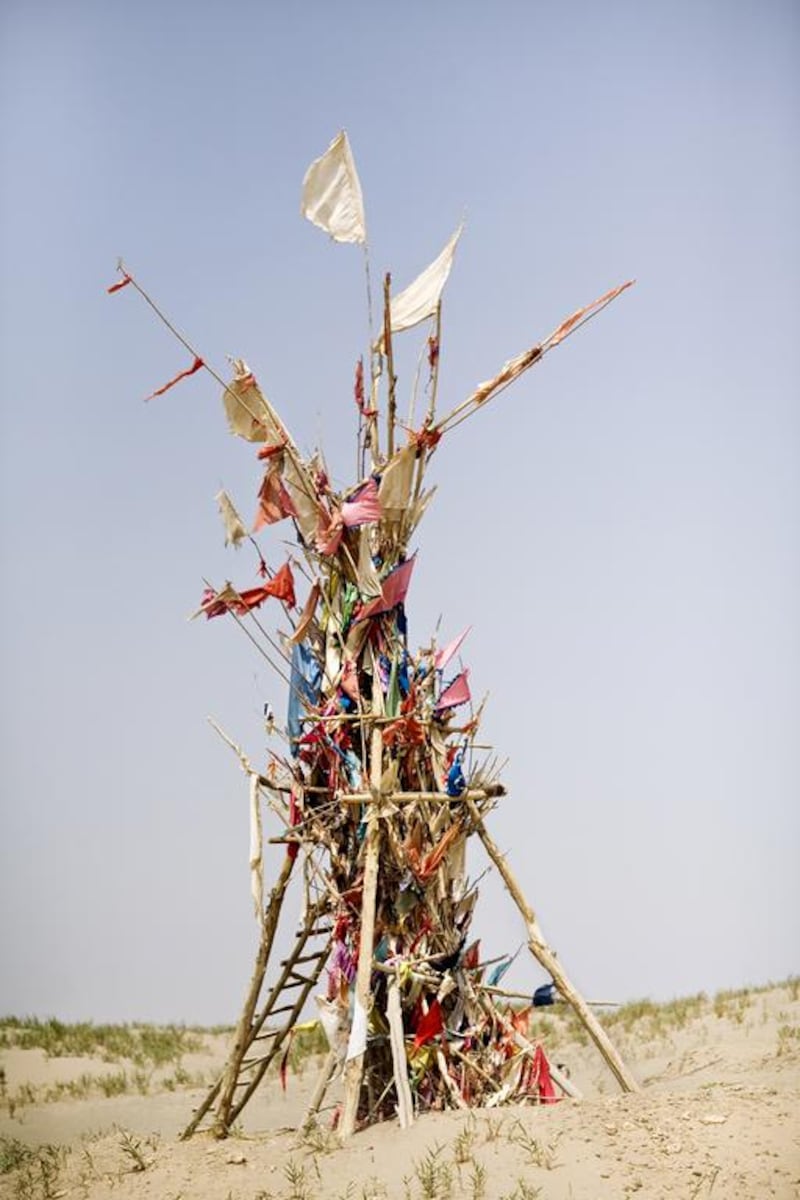Listening to a description of the materials that feature in Lisa Ross's photographic series Living Shrines, raises doubts as to where, exactly, the living element comes in.
The images include collections of wind-battered branches stuck into the sand with rudimentary strips of material tied to them, small piles of rocks and stones and wooden cage-like structures with hand-stitched flags attached to them.
The occasional tree or other natural landmark provides a little perspective to their size, but mostly the focus is on the inanimate objects.
However, when standing in front of one of the images the inner life is clear – one can feel a certain energy emitting from them.
Several of her images are on show at Dubai’s Gulf Photo Plus this month . They are, in fact, photographs of shrines to Sufi saints and other objects of religious pilgrimage taken in the Taklamakan Desert in the Xinjiang region of far western China.
This area, which takes more than three days to reach from Beijing, is largely undocumented. Ross has spent more than 10 years visiting and compiling her series.
The images go beyond the realm of photojournalism, however. Ross has deliberately left out the Uyghur people who made the shrines and regularly visit and worship at them. Instead, she considers the shrines her subjects, and manages to capture their uncanny spirituality in her elegant images.
“I think of the photographs as portraits of a relationship,” she says. “A continual relationship between the living and those who have passed. These are not what we would consider a cemetery but a place where people visit every Friday.”
The other reason she chooses not to include people from the local community in her images is that she wanted to try to reproduce for her viewers the experience she had.
“When I arrived in China, I was in a very spiritual place and instead of going to the Great Wall or other tourist sites, I headed out west and discovered these holy sites,” she says.
“The vocabulary of these images is based around how to relay this experience to my audience. There are no people in the images because I was not looking at other people. I want you to stand in front of this and feel something, whatever it is – just be moved in some way.”
In this, Ross has been successful. The sizes and framing of the images really transport the viewer to that spot in the middle of a remote Chinese desert. They do impart some of the spirituality as well as the enduring power of faith, which is ultimately what connects the viewer to the stories told by these shrines.
They also point to a rarely talked about political issue. The vast area of Xinjiang – which accounts for about a sixth of the Chinese mainland – was not always part of China. It has been a source of a power struggle between the Chinese and Russian governments through the ages, not least because of its oil-rich landscape and other natural resources. So, in a bid to gain control, the Chinese government has reduced the Uyghur shrines to cultural landmarks, making official religious worship illegal and imposing strict rules controlling other aspects of Muslim worship.
What this means is that these shrines, although in use now, might well come under threat.
“Unfortunately, a lot of the sites are becoming difficult to access for the community,” Ross says.
Also on display in the gallery is Ross’ book, Living Shrines of Uyghur China – Photographs by Lisa Ross, which was published in 2013 by the Monacelli Press.
It contains extended captions for many of the images, as well as essays by Beth Citron, curator of modern and contemporary art at the Rubin Museum of Art; Rahile Dawut, an Uyghur folklorist who accompanied Ross on several trips, and Alexandre Papas, a French historian of Central Asia, who also travelled with Ross throughout her journey.
This is the first time this work has been shown in the Middle East.
• Lisa Ross: Living Shrines is at Gulf Photo Plus until September 2. For more details, visit www.gulfphotoplus.com
aseaman@thenational.ae










